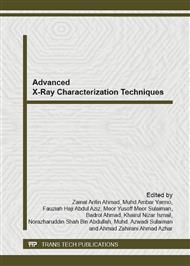p.142
p.147
p.151
p.156
p.161
p.166
p.173
p.179
p.186
Study on the Influence of Synthesis Temperature of Anatase TiO2 Nanoparticles for Electrophoretic Deposition
Abstract:
The purpose of this research is to study the effect of synthesis temperature in order to produce anatase TiO2 nanoparticles (NPs) without using strong acids. In this research TiO2 nanoparticles was prepared by the hydrolysis and condensation of titanium (IV) isopropoxide in water at synthesis temperature of 0°C ± 0.1°C which produced anatase TiO2 crystallite size of 4.66 nm. XRD (X-ray diffraction) was used to analyse the crystal structure of the TiO2 and to calculate the crystallite size of the TiO2 nanoparticles. Transmission electron microscope (TEM) was also used to characterise the morphology of the TiO2 nanoparticles.
Info:
Periodical:
Pages:
161-165
Citation:
Online since:
December 2012
Authors:
Keywords:
Price:
Сopyright:
© 2013 Trans Tech Publications Ltd. All Rights Reserved
Share:
Citation:


